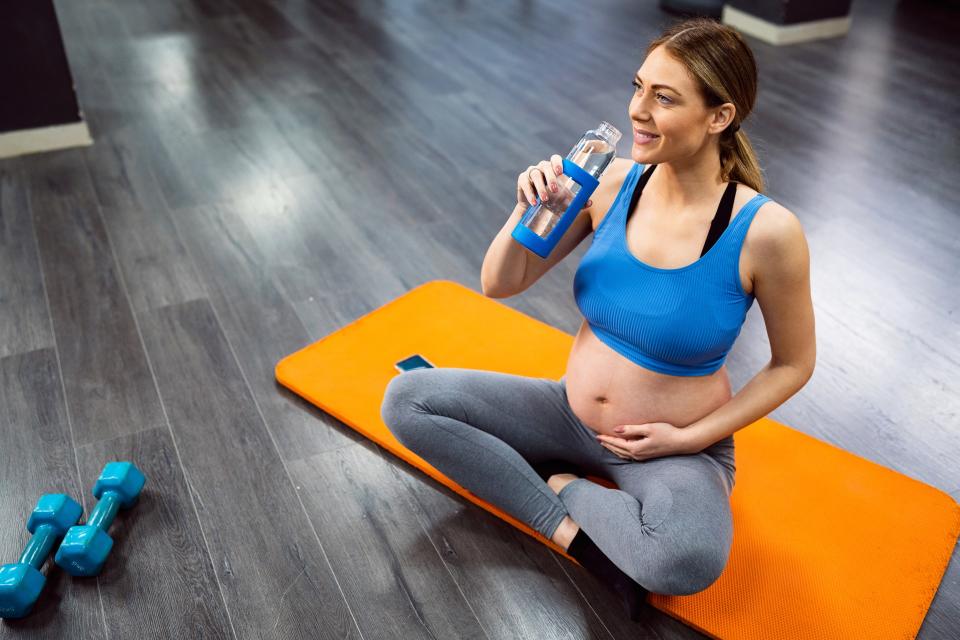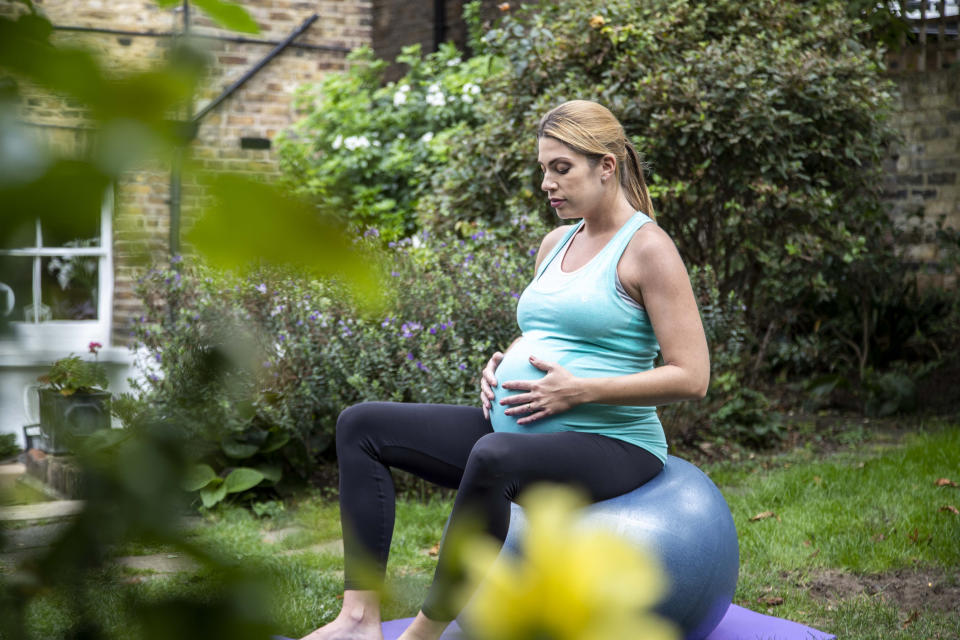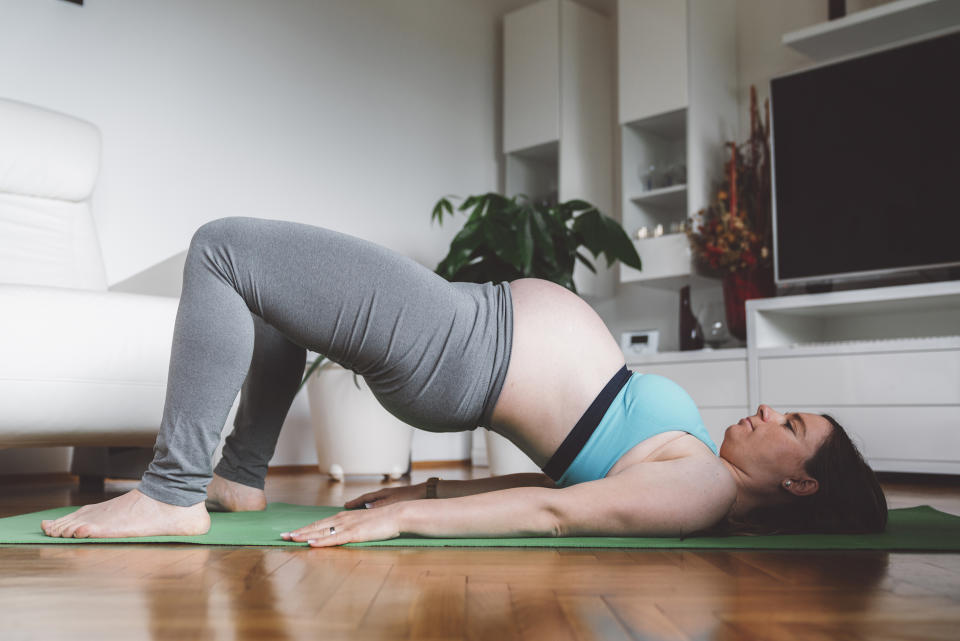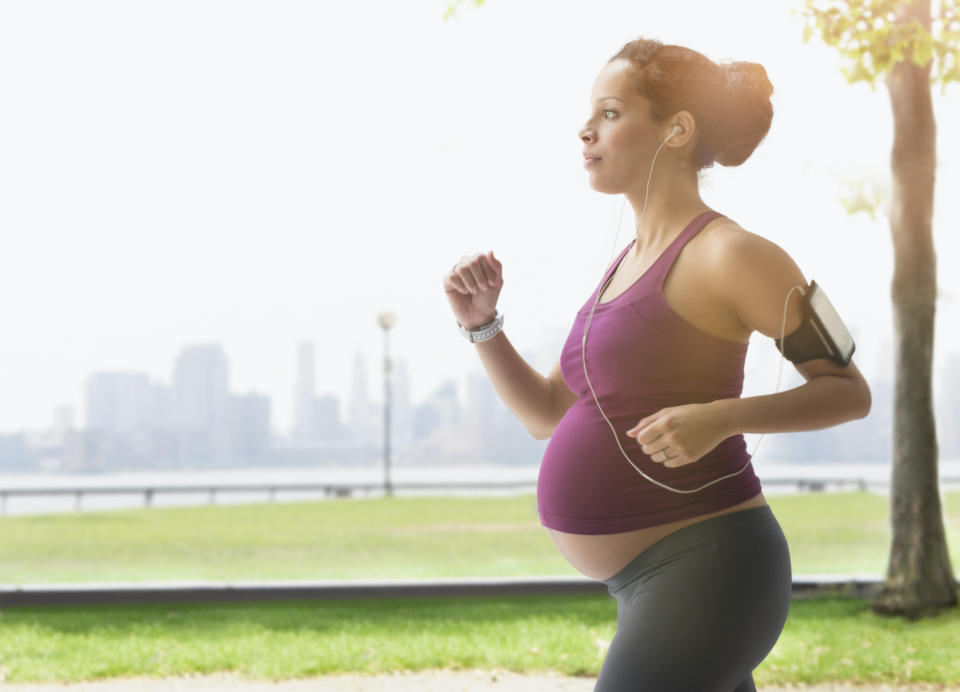Pregnancy exercises: How to make exercising during pregnancy safe

Pregnancy exercises can keep you happy and healthy throughout all of your trimesters, but you may be wondering what activities you can do safely.
The NHS confirms that exercise in pregnancy is good and safe for you and your baby. Not only does it help to manage pregnancy weight gain, but it also helps prepare your body for the stages of labour.
Official guidance from the UK’s Chief Medical Officer states that you should aim to do 150 minutes of moderate-intensity exercise a week, along with two strength-building activities.
There are specific activities you should avoid in order to stay safe whilst exercising in pregnancy. These include anything that risks ‘bumping the bump’ (such as contact sports or those with a higher risk of falling), as well as scuba diving and exercising at high altitude or in extreme temperatures.
Additionally, your body goes through such a physical transformation during pregnancy week by week that it’s important that any exercise both supports and adapts around these changes, too.
"Exercise during pregnancy can keep you energised and strong enough to carry a baby," says Anna Kaiser, a certified pre- and postnatal trainer and founder of Anna Kaiser studios. "Elevating your heart rate will help stimulate blood flow, reduce inflammation, increase energy and beat those baby blues, as long as you don't push yourself beyond what you're used to."
An active pregnancy can also help reduce pregnancy back pain and pelvic discomfort, and maintain good posture, says Shakira Akabusi, a pre and postnatal exercise specialist, mum of four and author of The Strong Like Mum Method book (from £3.99, Amazon).
So, unless you’ve been advised by your GP or midwife not to exercise, there are plenty of reasons to get active – provided you follow the expert advice in order to stay safe.
How to make exercising safe in pregnancy
Before you get started with your favourite pregnancy exercises, you might be wondering what can stay the same and what you need to do differently. Below, pre- and postnatal exercise experts share their top tips for safely working out during pregnancy.
Stick to a moderate intensity
It’s important to avoid intense exertion when exercising in pregnancy, as your oxygen supply becomes the baby's oxygen supply too. It’s OK to get a little out of breath, but anything that leaves you gasping for air should be avoided.
“A good indicator is the ‘talk test’,” says Rosie Stockley, an ante and postnatal exercise specialist and the founder of video workout platform Mamawell. “You should always be able to hold a conversation, even if you’re a bit out of breath.” It’s vital to be mindful of not holding your breath, too, she adds.
So does that rule out high-impact exercises? Not necessarily. “Running, jumping jacks, etc are fine if they're comfortable for you,” says Hollie – although she does suggest giving them a miss if they're "causing you to leak urine or faeces, or [break] wind.”
Stay hydrated
It's important for pregnant women to stay hydrated when they exercise to help maintain blood flow and regulate body temperature.
"You’re likely going to be peeing more often (due to your uterus squashing your bladder and reducing its volume) and, during pregnancy, we require more fluid in the body," says pre- and postnatal fitness expert Hollie Grant.

Beware of overheating
You should avoid raising your internal temperature too dramatically when exercising during pregnancy, as this could be harmful to you and your baby.
This is because the body combats overheating by diverting blood towards the surface of the skin in an effort to cool down, which in turn diverts blood away from vital internal organs. Overheating also increases your chances of dehydration and fainting – both potential
Hollie therefore advises: "Aim to wear layers that can be removed, open a window or avoid exercising during hot periods, unless you can find shade."
Wear a good sports bra
“Towards the later stages of pregnancy, we may notice a significant change in the size and weight of our breast tissue, so we may need more support," says Hollie, who warns: "The ligaments of the breasts are important and can be damaged if they aren’t supported.
She recommends Natal Active, Latched and Jorgen House for a fantastic range of maternity sports bras.

Listen to your body
Feeling tired is common in the early weeks of pregnancy, so be sure to honour how your body is feeling and rest where needed. "There will be some days where your growing baby will zap all your energy (they’re growing at a rapid rate, after all) and others where you feel fantastic. Listen to your body and do what feels right on the day," advises Hollie.
MORE: Pregnancy yoga online: the best pre-natal classes to try online
The benefits of exercise during pregnancy
Research highlights many benefits of exercising in pregnancy. They include a reduction in hypertensive disorders (those relating to high blood pressure), better cardiorespiratory fitness (comprising the heart, blood vessels and lungs), lower pregnancy weight gain, and a reduction in the risk of developing gestational diabetes.
Other benefits include:
Increased energy
Better sleep
Improved mood
Reduced risk of constipation
Reduced risk of back pain
Additionally, there's evidence to suggest that exercise can also help reduce the risk of complications during pregnancy and childbirth, plus it can help speed up recovery times post-birth.
Keeping active also helps your body deal with the physical strains it’s placed under both during and after pregnancy.
“The legs, glutes, pelvis, abdominals and lower back need to be strong to support the growing baby,” explains Anna
“Meanwhile, the upper back and chest need to be strong to support growing breasts and all the carrying that will need to be done post birth."
One study also found that keeping fit during pregnancy may help reduce the risk of a child developing high blood pressure later in life.

Pregnancy exercises in the first, second and third trimesters
“The exercises which are easiest or best will change throughout pregnancy,” explains NHS doctor Dr Dawn Harper.
It’s likely that your energy levels and mood will fluctuate during your pregnancy so it’s important to be mindful of how you are feeling on any given day.
But on the whole, staying fit and well is really important for both mother and baby in all three trimesters.
Pregnancy exercise in the first trimester
If you were active prior to pregnancy, you can generally carry on exercising as you did previously in your first trimester, provided you stick to a moderate level of intensity and avoid the activities deemed a no-no by the official guidelines.
And if you weren’t physically active before getting pregnant, it’s important to start gradually.
In both scenarios, it is important to be happy and comfortable with any activity that you do, and to pay attention to how your body feels.
"Physically not much has changed on the outside, but there are many hormonal adaptations as the baby begins to grow," says Rosie.
Feelings of tiredness are common in the early weeks of pregnancy. You also may be suffering with morning sickness. Be sure to honour how your body is feeling and rest where needed.
"You may not feel like doing your normal fitness routine in the first 12 weeks of pregnancy. Instead, a brisk walk may be perfect," says Rosie.
Pregnancy exercise in the second trimester
In the second trimester energy levels often return, making it a great time to get into a regular pregnancy fitness routine. However, you may need to make certain modifications to your workouts.
One key example is exercises that require you to lie flat on your back. NHS guidelines state you should avoid lying on your back for prolonged periods from 16 weeks onwards – which has obvious implications for activities such as Pilates and yoga.
Mixing up your workout routine can help you continue to exercise on your back, provided you stick to short periods of time and that it feels comfortable for you.
Hollie suggests an example routine:
Start with side-leg lifts on your left-hand side
Roll onto your back to do glute bridges for 30 seconds to a minute
Come up to sitting and do some rowing with a resistance band
Flip onto hands and knees to do glute kick-backs, working the left-hand side again
Lie on your right-hand side and repeat the routine again on the opposite side
"You will probably also find that as your pregnancy progresses you may want to reduce the intensity of your workouts,” says Dr Dawn. Shakira recommends aiming for around 70% of your max workrate, ensuring you can still pass the ‘talk test’.
You may also want to start reducing impact exercises, says Shakira, in order to avoid sudden impact in the core. “For example, you might modify burpees so that you’re not jumping up and back. Instead, you might reach up, then put your hands onto a bench or chair and step out.”
"You may well find that swimming and yoga are easier than jogging," adds Dr Dawn.

Pregnancy exercise in the third trimester
The growing weight of your bump and demands on your body may mean that you want to further reduce the intensity of exercise in your third trimester.
“Many women feel more fatigued and on some days might not feel like working out – or you might need to take longer breaks," Rosie says.
Certain positions may also prove more challenging, such as a four-point kneeling position. “Some women start to feel that being on all fours places too much pressure onto the abdominal wall, in which case we can raise our hands up onto a platform,” says Shakira.
Some women struggle with carpal tunnel syndrome, particularly in the third trimester, so you may need to adapt any workouts on your hands in order to feel comfortable.
“Some of my clients find doing something on their hands and knees more comfortable on their fists as opposed to their palm being flat,” says Shakira. “But then other people find the opposite, and find being on their fists aggravating.”
Others find that their feet flatten as pregnancy progresses. “This can impact the core and pelvic floor, as the shock absorption from your feet isn’t as efficient,” says Shakira.
She advises adding some arch rehab exercises into your routine. “Put a paper towel under your foot and then try to crunch it up with your toes to build strength in your arch,” she suggests.
Best pregnancy exercises for every trimester
It’s likely that your energy levels and mood will fluctuate during your pregnancy so it’s important to be mindful of how you are feeling on any given day, but overall, staying fit and well is really important for both mother and baby in all three trimesters.
Anna tells us: "Although it's almost impossible to build new muscle during pregnancy due to hormones, it's essential to maintain the muscle you already have so that you are prepared for your baby. Try incorporating strength training at least two times per week, along with any kind of cardio that makes you feel good."
Below are some examples of types of exercise that are great options to achieve just that throughout your pregnancy.
Swimming
Get the benefits
You can generally swim throughout pregnancy for as long as you feel able and, according to the American College of Obstetricians and Gynecologists, it’s one of the safest forms of exercise during pregnancy.
The hydrostatic pressure of the water helps to reduce swelling, improve the circulatory and respiratory system and lower blood pressure, and because it’s low-impact, there’s minimal stress on the joints.
How to swim in pregnancy safely
Breast stroke is a good swimming style because it opens and strengthens your chest. This prepares you for when you need to control your breathing in labour. Plus it opens your hips and encourages flexibility of the pelvis. Just remember to keep your back and neck straight in order to protect your back.
If you have difficulty, use a float under each arm or under your chest. Do as many lengths as you can but stop if you feel tired.

Pilates
Get the benefits
As a low-impact, moderate-intensity workout, Pilates is a great option during pregnancy. “Pilates helps maintain or build strength in the body that really helps as your body changes through pregnancy,” says Hollie.
The benefits, she says, include keeping the core, glutes and lower back active – all of which can support a healthy, happy pregnancy.
“I also really like the mind-body connection,” she adds. “With Pilates you have to really concentrate, so it might be twenty minutes or an hour where you’re just thinking about how your body feels, rather than thinking about all the things that come with becoming a mum.”
Additionally, research published in the journal BMC Pregnancy and Childbirth suggests that doing Pilates when pregnant can actually significantly reduce the pain experienced during labour and even "increase maternal satisfaction with the childbirth process."
How to do Pilates in pregnancy safely
If possible, attend a class that is specifically designed for pregnancy with an instructor who is qualified to teach prenatal Pilates. This way you will know that all the moves are safe for pregnancy, and that you’re getting the most from the class.
“If you join a generic class, you might find that there’s a few times that the instructor says, ‘you can’t do this exercise, or sit this one out’ - particularly if it’s something lying on your back.
You’ll also need to be mindful of modifying any moves that create pressure in the core, says Hollie, paying particular attention to something known as ‘doming’. This occurs when increased pressure is placed on the linea alba, the band of connective tissue that runs down your midline and naturally stretches during pregnancy as your ab muscles — the rectus abdominis — separate. “The tummy goes pointy like a Toblerone as pressure is pushed out through the gap between your rectus abdominis muscles,” explains Hollie.
Whilst this separation of the so-called ‘six-pack muscles’ (known as diastasis recti abdominis) is quite normal, with up to 70% of women experiencing it during pregnancy, any movement that causes hard doming should be modified accordingly. “If the doming is aggressive, uncomfortable and hard to the touch, it's worth regressing an exercise to reduce your risk of a hernia,” Hollie advises.
Again, a qualified prenatal Pilates instructor can ensure you continue to practise safely.
Pelvic floor exercises
Get the benefits
As the set of muscles responsible for supporting the uterus (as well as the bladder and bowel), it’s no surprise that the pelvic floor comes under increasing strain during pregnancy – which, in turn, can result in stress incontinence (urine leaks caused by pressure on the bladder, such as by sneezing or jumping).
Research has confirmed that pelvic floor exercises can help prevent such leaks, both during pregnancy and during the early post-partum stage, and the NHS recommends all pregnant women practise them whether you experience stress incontinence or not.
How to do pelvic floor exercises in pregnancy safely
Pelvic floor exercises themselves are relatively straightforward to do. They involve contracting your anus, vagina and urethra at the same time, holding for a short time, and then releasing.
However, there are plenty of exercises that work the pelvic floor when you’re not even thinking about it, and as such are great to do during pregnancy. Shakira suggests moves that engage the whole core, such as bridges, glute kickbacks, lunges and squats.
Anna also highlights the need to breathe correctly in order to make pelvic floor effective. “Many of us rely on our secondary breathing muscles in our neck and shoulders, but it is integral during pregnancy that we focus on dropping our breath into our diaphragm to condition our transversus abdominis [deep ab muscles] and pelvic floor muscles,” she says.
Posture is key. Start by sitting or standing tall, with your shoulders over your hips. Sitting on a Swiss ball can help find the correct position, Anna shares.
"With proper posture, put your hands on your belly. On your inhale, fill your belly up in your hands and then pull your belly button in as you exhale.”
Running and walking
Get the benefits
Running can be a great way to tick off some of those 150 minutes’ worth of moderate weekly exercise.
Indeed, commenting on a research that found no negative effects of running whilst pregnant, Professor Janice Rymer, Vice President for Education at the Royal College of Obstetricians and Gynaecologists (RCOG), said: “We recommend that all women take part in regular exercise during pregnancy as it can help to reduce fatigue, lower back pain, varicose veins, swelling of the ankles, and feelings of stress, anxiety and depression.
“This new study shows that, in the majority of cases, it is safe for both the mother and the baby if a woman who runs regularly continues to do so during her pregnancy.”
Of course, some days lacing up your running shoes might be the last thing you feel like doing, particularly in the first 12 weeks of pregnancy. “Instead, a brisk walk may be perfect,” says Rosie.

How to do running and walking in pregnancy safely
Whether running or walking, it’s important to stretch before you head out to ensure you don’t pull any muscles.
If you ran prior to pregnancy, it’s fine to continue provided it feels comfortable for you. Shakira says: “You can continue running during pregnancy if your core is used to managing the impact, but there are modifications that we need to make and additional exercises we can do to make sure we’re supporting the body.”
These include managing the pace of your runs in order to stick to a moderate intensity, and adding whole-body strengthening exercises to the mix in order to support a strong core, back and pelvic floor. It’s also important to stick to flatter terrain to minimise the risk of falls.
If you didn’t run before pregnancy, brisk walking is a great alternative. Just be sure to apply the same principles of intensity and strength training.
Yoga
Get the benefits
Studies also show that prenatal yoga may result in less labour pain, a shorter labour and a reduced risk of premature labour.
Yet pregnancy yoga specialist Clare Maddalena believes it’s the mental benefits that mums feel the most. Pregnancy yoga can give you the time to come to terms with the many changes pregnancy brings, whilst readying yourself for labour.
How to do yoga in pregnancy safely
As with Pilates, it’s best to attend a specialist pregnancy yoga class with a prenatal-trained instructor. Similarly, pay special attention to moves that work your core and pelvis, or those that require you to lie on your back.
With all moves, it’s also important not to overstretch in order to avoid injury, which is more common during pregnancy thanks to the body producing more of the hormone relaxin. “It prepares the body for childbirth by relaxing the ligaments around the joints,” explains Rosie. “It’s particularly useful in the pelvis, but can make other joints less stable."
Pregnancy exercises to avoid or modify
It's essential that pregnant women avoid anything that may put them or their baby in harm's way. That includes any activity that risks ‘bumping the bump’, along with specific sports and activities as detailed below.
Contact sports: Activities such as martial arts, football, rugby, squash and hockey all carry a risk of impact.
Activities that risk falling: This includes pursuits such as horse riding, cycling, skiing and gymnastics.
Scuba diving: This is inadvisable for pregnant women due to the risk of decompression sickness or gas embolism.
Exercises at high altitude: Avoid working out at or above 2,500m above sea level until you have acclimatised, due to the risk of altitude sickness.
Exercises in extreme heat: Including Bikram yoga – experts agree that pregnant women should avoid raising their core body temperature to this degree.sickness.
Exercises done lying on your back: After 16 weeks, you should avoid lying on your back for prolonged periods, as this can put pressure on the vena cava, a large vein that carries blood to the heart. It’s therefore best to keep these exercises to a minimum, and stop if you feel sick, lightheaded or dizzy.
Can I hurt my baby by exercising?
The NHS says that exercise is not dangerous for your baby, but if you're in doubt at any point during your pregnancy, you should consult your maternity team.
If you’re exercising in a ‘normal’ manner, then there shouldn’t be any risk of harming your baby, says Rosie. "You’ll want to be careful of any direct impact. So, avoid workouts that could involve you getting hit in the stomach, or falling over – such as falling off a bike," she warns. "Extreme straining or holding of breath should be avoided, so don’t start lifting really heavy weights during pregnancy."
If you want to join an exercise class that isn’t specifically for pregnancy, check first that your instructor is trained to teach pregnant women.
When should a pregnant woman stop exercising?
You can keep going with your exercise routine, provided you follow the guidelines and adapt your workouts to suit your body’s changing needs and energy levels.
However, you should always stop any exercise during any stage of your pregnancy if you experience pain, bleeding, dizziness, nausea, an abnormally elevated heart rate or any other unusual symptoms, such as lack of normal foetal movement, and seek immediate medical assistance.
Dr. Dawn adds that you should only exercise in a way that works for you. It’s incredibly important to listen to your body. “If it hurts, don’t do it,” she advises.
“When you are pregnant, if it feels wrong it probably is. So stop and take advice from your midwife, doctor or, if you are a member of a gym or sports group, the trainers. You may not need to give up all exercise but you may be advised to alter your schedule or try some different activities."

 Yahoo News
Yahoo News 
